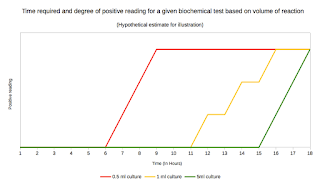Angiostrongylus cantonensis
By the end of April this year, rat lungworm or Angiostrongylus cantonensis raised an alarm with 6 cases which was apparently spreading on the Hawaiian island of Maui. The infection is called as angiostrongyliasis. it basically manifests as meningitis and if not treated can cause permanent damage to the central nervous system or death. A cantonensis is well known in South-east Asian and Pacific region and is one of the most common causes of eosinophilic meningitis. The More recently, the parasite is been found in environments of California, Alabama, Louisiana Leon and Florida regions including Alachua, Saint Johns, Orange, and Hillsborough (Where it is much more common than originally realised).
 |
| Photo 1: Adult female of A cantonensis. Source |
A cantonensis is a species related to Strongyloides stercoralis (Order strongylida, and superfamily metastrongyloidea) was first described from CSF of an eosinophilic meningitis case by Nomura and Lim in Taiwan in 1944. Morphologically, they appear like other nematodes unsegmented with a simple fully developed gastrointestinal system. Males are smaller than the females. Photo 1, shows an adult female with a dark red digestive organ, two white reproductive organs, and a transparent cuticle.
 |
| Photo 2: A cantonensis egg. Source |
A cantonensis is classically an infection of rats and humans are accidental hosts. A cantonensis reside in pulmonary arteries of rats. A female lays up to 15000 eggs a day. Once eggs are laid, they hatch and the first stage larva migrates up the pharynx and are swallowed to be secreted through faeces. Snail forms an intermediary host which is infected with the larva where it develops. The 3rd stage larva in the intermediate host is the infective stage. It enters through contaminated water, ingestion of snails the larva migrates up the brain. The larvae develop into a pre adult stage and then return to the pulmonary artery, where it matures.
 |
| Fig 1: Life cycle of A cantonensis.Source |
Many species of snails and slugs serve as intermediate hosts for A cantonensis. Some of the well known vectors include Achatina fulica (African land snail), Pila species, golden apple snail etc
Humans acquire the infection accidentally through ingestion of contaminated water, other infected paratenic animals (crabs, freshwater shrimps) or leafy vegetables which are not cleaned and washed well.Fig 1 from CDC page gives a detailed picture of the life cycle.
The clinical presentation will usually involve symptoms such as abdominal discomfort which progress to fever and headache. Often the case will self resolve without treatment and may not be evident. In cases of high load of parasites, the infection progresses to serious meningitis. The laboratory diagnosis is at best, a prediction. Eosinophilic meningitis and imaging studies maybe a clue. To date, there are no definitive diagnostics available. It should be noted that eosinophilic meningitis is not a definitive indicator for A cantonensis. Other agents include Angiostrongylus costaricensis, Gnathostoma spinigerum etc. Though PCR testing is available it is done only in special labs and not widely available.
In a recently published article in Digital Journal by Karen Graham, there is a discussion on what increased identification of A cantonensis means in Florida. As Heather Stockdale Warden comments, "The ability for this historically subtropical nematode to thrive in a more temperate climate is alarming. The reality is that it is probably in more countries than we found it in, and it is also probably more prevalent in the southeastern U.S. than we think".
References:
Stockdale Walden, H., Slapcinsky, J., Roff, S., Mendieta Calle, J., Diaz Goodwin, Z., Stern, J., Corlett, R., Conway, J. and McIntosh, A. (2017). Geographic distribution of Angiostrongylus cantonensis in wild rats (Rattus rattus) and terrestrial snails in Florida, USA. PLOS ONE, 12(5), p.e0177910.





Comments
Post a Comment